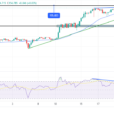Just around 2:14am local time (2am EDT), Asian traders were surprised to observe in the Chinese market something which until recently had been a purely development market phenomenon: a flash crash. A sudden plunge by Chinese stocks in Hong Kong had traders scrambling to find a trigger for the slump that coincided with a surge in futures volumes Bloomberg writes.
The Hang Seng China Enterprises Index tracking some of the nation’s biggest companies tumbled from an advance of 1 percent to a loss of 1.5 percent in about two minutes, before rebounding to a gain. Stocks including Tsingtao Brewery Co. and PetroChina Co. fell sharply at 2:14 p.m. in Hong Kong before paring losses. The same shares in Shanghai didn’t replicate the move.

There was no immediate explanation for the move. “Everyone is trying to figure it out,” said Jackson Wong, associate director at Huarong International Securities Ltd. in Hong Kong. “We have been trading on low volume without any major news, so there may have been something that triggered some bigger funds to sell a certain position or using futures to hedge and that triggered the domino effect for that moment. But that’s only my speculation.”
As Bloomberg adds, more than 5,000 May futures on the H-shares gauge changed hands in a minute from 2:14 p.m. as the price of the contracts slumped 143 points. Before that, volume in each minute of trading on Monday had averaged about 200 contracts. Hong Kong’s exchange operator hasn’t received any reports of erroneous trades and is closely monitoring market activities, spokeswoman Lorraine Chan said in an e-mailed response to questions.
The volatility comes at a testing time for Hong Kong traders in the wake of China’s stock market meltdown. The measure of 40 Chinese companies entered a technical correction on Friday after falling more than 10 percent from its recent high as a bull-market rebound unraveled. Data over the weekend showed the nation’s industrial production, retail sales and investment in April all trailed estimates. The gauge is down 14% this year to be among the world’s worst performers and extending 2015’s 19 percent rout.












Leave A Comment